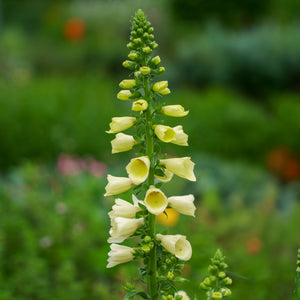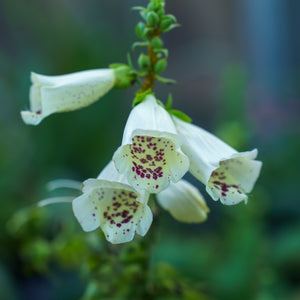The Digitalis Guide
Digitalis, more commonly known as foxglove, is a dramatic and elegant genus of flowering plants famous for its tall spires of tubular blooms and lush rosettes of foliage. Known for their cottage garden charm and pollinator appeal, digitalis plants create vertical interest and seasonal drama in both formal and wild-style plantings. With colors ranging from creamy yellows and warm peaches to vivid purples and soft pinks, foxgloves are a favorite for gardeners who value beauty, biodiversity, and impact.
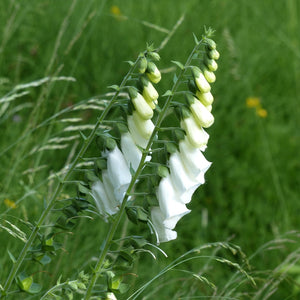
About
Digitalis is a genus in the Plantaginaceae family, comprising about 20 species native to Europe, western Asia, and northwestern Africa. The name “foxglove” is thought to derive from folklore describing foxes using the flowers as gloves to silence their steps while hunting.
Digitalis is best known for its towering flower spikes—often reaching 2 to 5 feet tall—lined with bell-shaped blossoms. Most species are biennials, forming a rosette of leaves in the first year and flowering in the second, but modern hybrids have introduced reliable perennials and even reblooming varieties to the market.
Popular cultivars include Digitalis purpurea 'Dalmatian Purple', known for its early blooms and compact size; 'Camelot Cream' and 'Camelot Rose' from the Camelot series, prized for sturdy stems and vivid colors; and Digitalis x 'Pink Panther', a modern selection offering improved reblooming. Digitalis grandiflora and Digitalis lutea are perennial species with soft yellow tones, while Digitalis × mertonensis bridges the gap between annual performance and perennial hardiness with rosy copper blooms. For season-long color, Digitalis 'Arctic Fox Rose' offers true perennial performance.

PLANTING
Digitalis plants thrive in cool climates with partial sun and rich soil. Careful site selection helps extend bloom time and plant health:
- USDA Hardiness Zones: Most varieties are hardy in Zones 4–9, though perennial forms like D. grandiflora may survive in colder zones.
- Soil: Prefers moist, well-drained, humus-rich soil. Slightly acidic to neutral pH is ideal.
- Sunlight: Partial shade to full sun. In hot climates, some afternoon shade helps protect flowers and foliage.
- Watering: Keep soil consistently moist but not soggy, especially during blooming season.
- Spacing: Space 12–18 inches apart depending on variety.
- Planting Time: Spring or fall planting is ideal. Mulch to retain moisture and suppress weeds.
When planting foxgloves, especially biennial types, consider sowing seeds in summer for blooms the following year. Perennial hybrids can be planted like other flowering perennials and may bloom their first year.
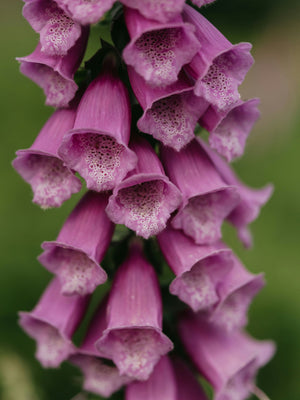
CARE
Though digitalis is often low-maintenance, a few key care steps ensure beautiful results and plant longevity:
- Watering: Water regularly, especially in dry conditions. Avoid overhead watering to reduce the risk of leaf spots or mildew.
- Fertilizing: Apply a balanced fertilizer in early spring. Avoid excess nitrogen, which can encourage leafy growth over blooms.
- Deadheading: Remove spent flowers promptly to encourage secondary blooms and reduce unwanted reseeding.
- Staking: Taller varieties may require support to keep the flower spikes upright in wind or heavy rain.
- Pests & Diseases: Foxgloves are generally pest-resistant but may be affected by aphids, spider mites, or fungal leaf spots.
- Winter Care: Mulch in fall for insulation. In colder zones, cut back foliage after the first frost.

HOW TO USE
Digitalis is a standout in a variety of garden settings. Its striking form, height, and color palette make it a key player in layered designs:
- Cottage Gardens: Plant behind delphinium, hollyhocks, or roses for romantic vertical interest.
- Pollinator Gardens: A favorite of bees and hummingbirds due to its tubular, nectar-rich blooms.
- Woodland Edges: Performs well at the transition between full shade and sun.
- Cut Flower Gardens: Foxglove stems are long-lasting and dramatic in floral arrangements.
- Back-of-Border Plantings: Provides a vertical backdrop for mounding or trailing perennials.
Pair Digitalis with companions like campanula, salvia, echinacea, geranium, or nepeta for continuous bloom and varied textures. Their statuesque form contrasts beautifully with rounded, low-growing plants and ornamental grasses.
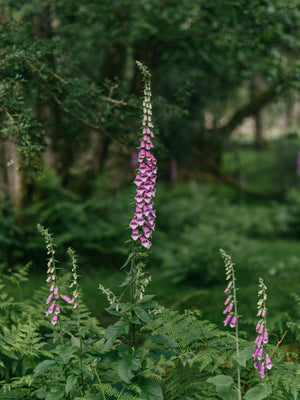
COMMON QUESTIONS
- What is Digitalis? Digitalis is a genus of flowering plants known for tall spires of tubular flowers and their traditional use in heart medications (under strict medical guidance).
- Is Digitalis poisonous to dogs? Yes, all parts of the plant are highly toxic to dogs if ingested.
- Is Digitalis poisonous to cats? Yes, it is equally toxic to cats and should not be accessible to pets.
- What is Digitalis used for? In medicine, certain compounds from Digitalis (like digoxin) are used to treat heart conditions. These should never be self-administered.
- How to grow Digitalis? Provide moist, well-drained soil, partial sun, and regular watering. Deadhead to prolong blooming.
- Do deer eat Digitalis? Deer typically avoid Digitalis due to its toxicity.
- Is Digitalis a perennial? Some are biennials (like Digitalis purpurea), while others (like Digitalis grandiflora) are perennials. Many hybrids offer perennial or reblooming traits.
- Where to plant Digitalis? Plant in partial sun with rich, moist soil and protection from harsh afternoon sun or wind.
- How to care for Digitalis? Water regularly, fertilize in spring, deadhead faded blooms, and mulch in winter for protection.
Conclusion
With their towering blooms and vintage charm, Digitalis offers bold vertical structure and pollinator-friendly beauty in a variety of garden styles. Whether you opt for traditional spires like 'Dalmatian Peach' and 'Excelsior Group' or modern rebloomers like 'Arctic Fox Rose' or 'Pink Panther', foxgloves bring a fairytale elegance that few other plants can match. With proper care, they’ll fill your borders with color and grace from late spring to mid-summer.
The Digitalis Collection
Sold Out
Sold Out
Sold Out
Sold Out
Sold Out

